
Oxydendrum arboreum
Sourwood, the lone species of the genus, is found in
woodlands and along streams of eastern North America. This plant (named
for the sour taste of its leaves) forms a pyramidal tree to 30 feet tall, with
canoe-shaped, glossy leaves that turn vivid maroon, yellow, or purple in
autumn. In late summer, its delicate panicles of fragrant, urn-shaped
flowers spray forward, decorating the tree in white. The blossoms, which
resemble lily-of-the-valley, are followed by yellowish seed capsules that turn
brown and persist into winter. It makes an outstanding specimen both for a
prominent position and also for a naturalized setting.

Black Magic Elephant Ear
Large striking, dusty purple-black foliage contrasts
spectacularly with bright-colored plants. Spreads freely in rich, wet soils;
more slowly in dry, clay soil. Adds bold color and tropical flair to any
garden. Herbaceous.
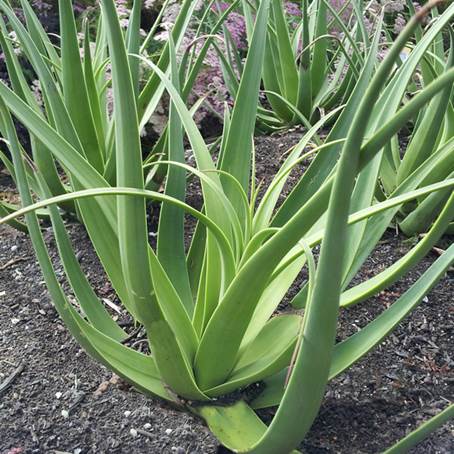
Calamar Squid Agave
Rare, non-clumping form of Agave. Spineless blue-green
leaves emerge vertically from a center rosette and arch gracefully to the
outside of the plant. Rarely flowers. An interesting container or dry rock
garden specimen. Combine with low perennials or other Cacti and Succulents.
Evergreen.
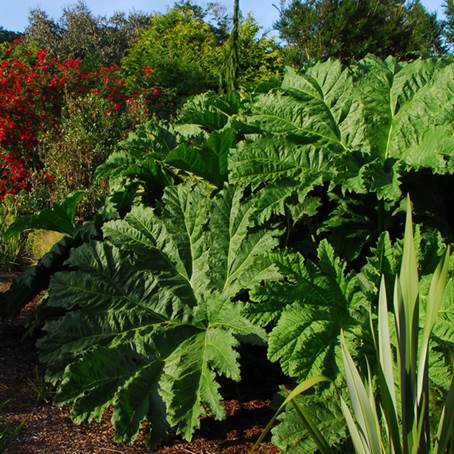
Chilean Prickly Rhubarb
Enormous, puckered leaves of this tropical, prehistoric
plant emerge in spring, reaching six feet across or more, creating a dramatic
waterside or greenhouse specimen. In late spring, a robust stalk bearing
brownish-bronze inflorescence adds to the exotic appeal. Evergreen in
frost-free areas.
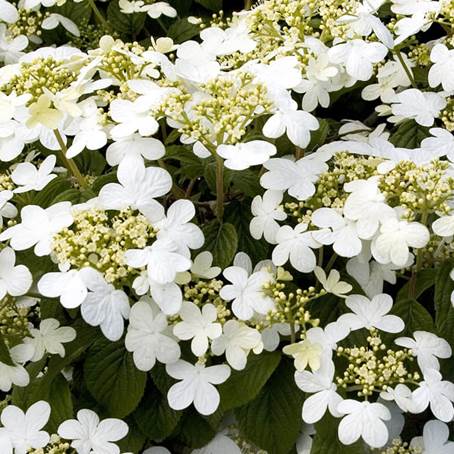
Summer Snowflake Viburnum
Broadly rounded form to this medium size shrub. Its tiered
horizontal branches magnificently display the large, flat flower clusters. Red
fruit in fall is very ornamental.
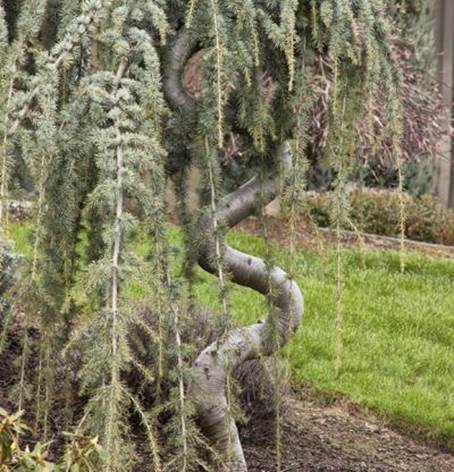
Weeping Blue Atlas Cedar
A dramatic, drooping form makes this attractive conifer a
special addition to any landscape. Use as a large specimen or accent. Pendant
branchlets display icy-blue needles. Evergreen.
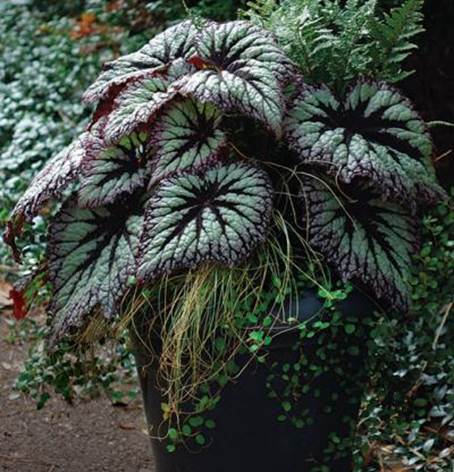
Begonia 'Fireworks'
Like other Rex begonias, 'Fireworks' is noteworthy for the
coloration of its foliage. Its silvery leaves are edged in purple and have a
black burst of fireworks in the center. Use it in a container or shady garden,
or grow it as a houseplant.
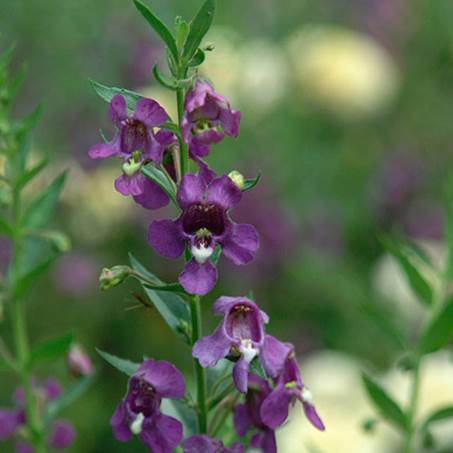
Angelonia angustifolia
Upright, low perennial with deep mauve to violet two-lipped
flowers blooming all summer. Angelonia are superlative container plants, and
can also be grown as bedding annuals.
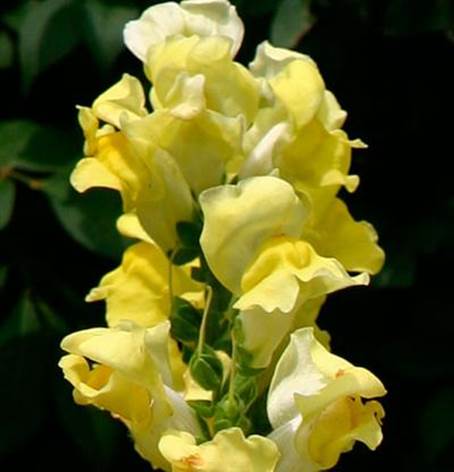
Antirrhinum majus
This plant produces upright racemes of two-lipped flowers
with spreading, rounded lobes in a vast arrray of warm colors. It flowers
profusely summer through autumn.
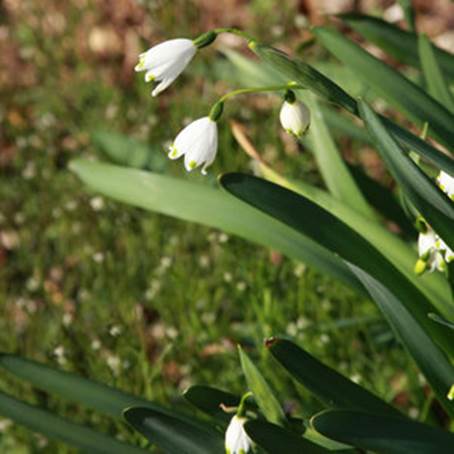
Leucojum aestivum 'Gravetye Giant'
One of the first plants to emerge, this 24-inch-tall bulb
bears nodding white bells as early as mid-January. Blooms are faintly
chocolate-scented; leaves are glossy, erect, and strap-shaped.

Zephyranthes reginae
These Mexican native bulbs actually offer demanding
gardeners flowers on demand. They produce strappy foliage to 12 inches
tall and clusters of buttery-yellow, starry, crocus-like blossoms two to three
days after every rain in summer and early autumn. Or, if it doesn't rain,
simply water and fertilize three days prior to your intended display, and the
moisture will prompt the flowers to appear, hence the common name,
rainflower. These bulbs are widely adaptable to diverse soil
conditions, and may be grown in full sun to partial shade, but they
prefer some shade.
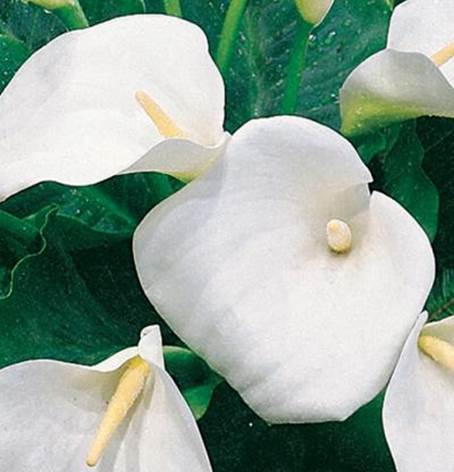
Zantedeschia aethiopica
The most familiar calla, this 3-foot-tall and 2-foot-wide
plant has large white flowers—up to 10 inches long—that surround a creamy
yellow fingerlike centerpiece. They bloom from late spring to
mid-summer. The upright, arrow-shaped leaves are solid green and glossy.
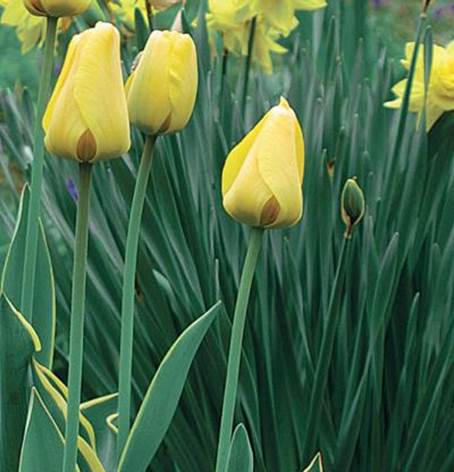
Tulipa 'Silverstream'
Reaching 20 to 24 inches tall, Tulipa 'Silverstream' has
chartreuse and yellow flowers suffused with red-and-rose markings that create a
watercolor effect. The foliage has distinct cream-colored edging. Grouping
these in a garden with a pastel palette would have driven Monet viridian with
envy.
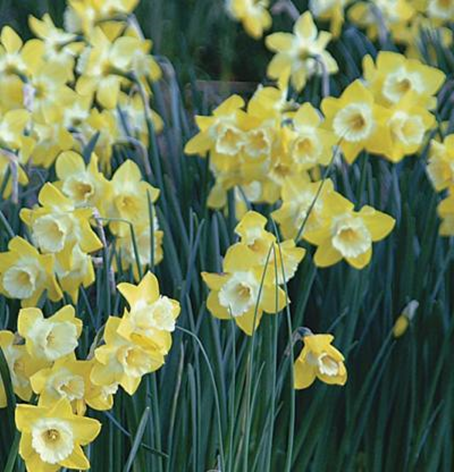
Narcissus 'Intrigue'
The newly
opened blossoms are a soft chartreuse-yellow. As they mature, however,
the flowers become a luminous white and attract a lot of attention, especially
when planted with a blood-red tulip like ‘Hollandia’. When combined with
another soft-colored flower, like Hyacinthus orientalis ‘Lady Derby’, it
creates a peaceful scene. An American-bred jonquilla-type daffodil with several
flowers per stem, ‘Intrigue’ also has a wonderful fragrance.
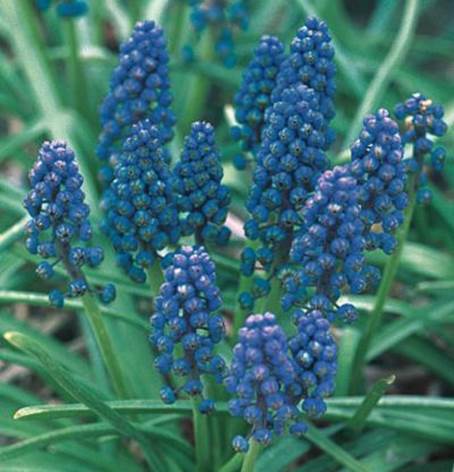
Muscari armeniacum 'Saffier'
Grape hyacinths are hardy, easy to grow, and have
long-lasting blooms--no garden should be without them. 'Saffier' is a good
candidate for beds and borders because it increases only by
division. Its strong, rigid flower stalks start celery-green and mature to
robust medium-blue blossoms with distinct pale-green lips at the mouth of each
floret. The constricted openings prevent access to pollinating insects,
resulting in blooms that last a full month and making them excellent cut
flowers.

Lilium 'Star Gazer'
Often used by florists, 'Star Gazer' lily has bright crimson
flowers with purple spots and dark edges. These lilies grow to about 3 feet
tall, so they generally don't need staking.

Hymenocallis narcissiflora
This bulb blooms in early summer with striking,
sweetly-scented white and yellow flowers that appear on leafless stems up to 24
inches tall. Petals curve up to accent a daffodil-like cup, sometimes with
green-striped tubes. Peruvian daffodil has long, strap-shaped, arching, dark
green leaves.
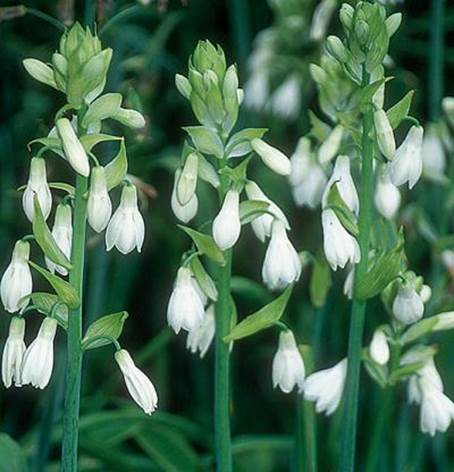
Galtonia candicans
A native of South Africa, summer hyacinth sends up spikes of
lovely white flowers in late summer amidst dark green, strap-like foliage, when
many other perennials are done blooming. The tall spikes are fragrant and
especially dramatic planted with darker foliage or flowers.

Eucomis comosa 'Oakhurst'
This bulbous perennial has striking reddish purple,
strap-like leaves and foot-long purple flowers that resemble pineapples in
late summer. Grow in a sunny border, container, or greenhouse. Plants
used outdoors may be overwintered in a frost-free location. The species is
native to South Africa.
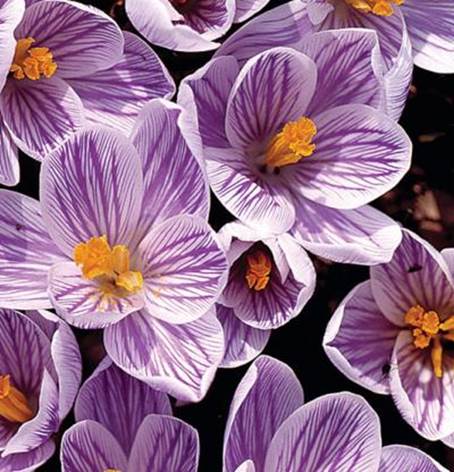
Crocus vernus
Dutch crocus is one of the hardiest, if not the hardiest,
crocus species readily available to home gardeners. A true harbinger of
spring, it can be planted in borders, rock gardens, and even lawns. After
flowering, the foliage must be left intact until it withers, which may cause
lawn-mower anxiety in some gardeners. Often sold as "mixed crocus,"
cultivars of this species are typically white, lilac, or purple and white
striped.
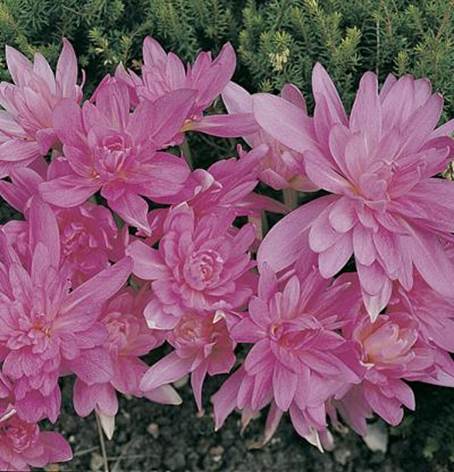
Colchicum 'Waterlily'
Semi-erect, narrowly ovate leaves 7-10 inches long appear in
spring and disappear by summer, followed by large, fully double, rosy lilac
flowers resembling the blooms of a waterlily.

Allium giganteum
In summer, this plant bears large rounded flower
heads up to 4 inches across with a multitude of star-shaped
lilac-pink flowers.
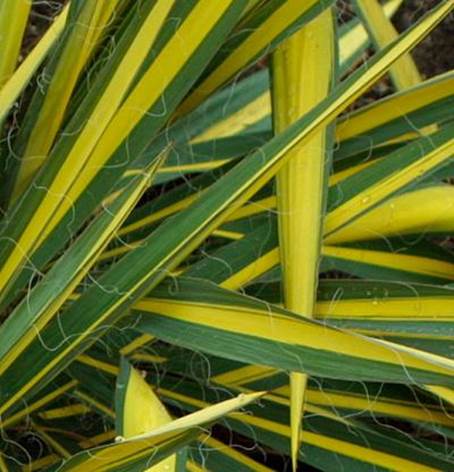
Yucca filamentosa ‘Color Guard’
This dramatic architectural plant is one of the most
beautiful variegated yuccas on the market. Its sword-shaped leaves
bear bold central stripes of bright canary-yellow against a rich celadon
edge. In cool weather, margins are tinged pink, and the entire yellow stripe
turns rose-colored on many of the leaves, lasting through early spring. Plants
grow to 2 feet wide and nearly as tall. Branched clusters of nodding,
creamy-white bells open in mid-summer on stout stems that reach 6 feet tall.

Tiarella 'Spring Symphony'
This reblooming, clump-forming variety blooms in
spring, producing 15-inch spires densely packed with pink blossoms.
Its deeply cut foliage is compact, with black markings along the midrib. Plants
grow to about 10 inches tall and wide.
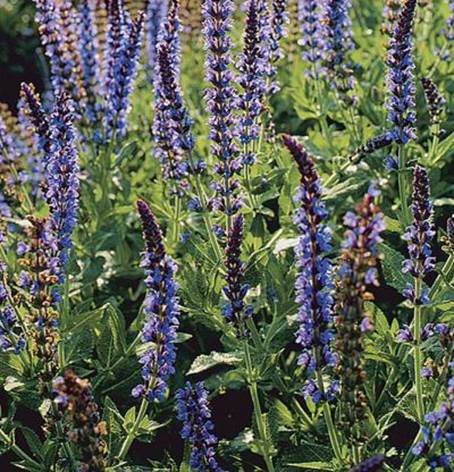
Salvia × sylvestris 'May Night'
This drought-tolerant perennial bears deep violet-blue
flower spikes in early summer and then sporadically if spent flowers are
removed promptly. It forms an erect clump 2.5 feet tall by 1.5 feet wide,
with wrinkled, soft hairy leaves.

Polygonatum odoratum 'Variegatum'
Gracefully arching 2 to 3-foot tall burgundy stems support
narrow leaves streaked in pure white. From late spring to early summer, this
species bears white flowers that mature into spherical black fruit in autumn,
when the foliage turns a golden yellow. Variegated Solomon's seal is a
fine choice for a shady bed.